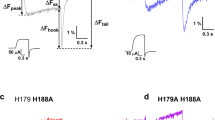Abstract
A voltage sensitive phosphatase was discovered in the ascidian Ciona intestinalis. The phosphatase, Ci-VSP, contains a voltage-sensing domain homologous to those known from voltage-gated ion channels, but unlike ion channels, the voltage-sensing domain of Ci-VSP can reside in the cell membrane as a monomer. We fused the voltage-sensing domain of Ci-VSP to a pair of fluorescent reporter proteins to generate a genetically encodable voltage-sensing fluorescent probe, VSFP2.3. VSFP2.3 is a fluorescent voltage probe that reports changes in membrane potential as a FRET (fluorescence resonance energy transfer) signal. Here we report sensing current measurements from VSFP2.3, and show that VSFP2.3 carries 1.2 e sensing charges, which are displaced within 1.5 ms. The sensing currents become faster at higher temperatures, and the voltage dependence of the decay time constants is temperature dependent. Neutralization of an arginine in S4, previously suggested to be a sensing charge, and measuring associated sensing currents indicate that this charge is likely to reside at the membrane-aqueous interface rather than within the membrane electric field. The data presented give us insights into the voltage-sensing mechanism of Ci-VSP, which will allow us to further improve the sensitivity and kinetics of the family of VSFP proteins.





Similar content being viewed by others
References
Akemann W, Lundby A, Mutoh H, Knöpfel T (2009) Effect of voltage sensitive fluorescent proteins on neuronal excitability. Biophys J 96:3959–3976
Alabi AA, Bahamonde MI, Jung HJ, Kim JI, Swartz KJ (2007) Portability of paddle motif function and pharmacology in voltage sensors. Nature 450:370–375
Bezanilla F (2000) The voltage sensor in voltage-dependent ion channels. Physiol Rev 80:555–592
Claydon TW, Vaid M, Rezazadeh S, Kwan DCH, Kehl SJ, Fedida D (2007) A direct demonstration of closed-state inactivation of K+ channels at low pH. J Gen Physiol 129:437–455
Dimitrov D, He Y, Mutoh H, Baker BJ, Cohen L, Akemann W, Knöpfel T (2007) Engineering and characterization of an enhanced fluorescent protein voltage sensor. PLoS One 2:e440
Hille B (1992) Ionic channels of excitable membranes. Sinauer Associates, Sunderland
Hossain MI, Iwasaki H, Okochi Y, Chahine M, Higashijima SI, Nagayama K, Okamura Y (2008) Enzyme domain affects the movement of the voltage sensor in ascidian and zebrafish VSPs. J Biol Chem 26:18248–18259
Knöpfel T, Tomita K, Shimazaki R, Sakai R (2003) Optical recordings of membrane potential using genetically targeted voltage-sensitive fluorescent proteins. Methods 30:42–48
Koch HP, Kurokawa T, Okochi Y, Sasaki M, Okamura Y, Larsson HP (2008) Multimeric nature of voltage-gated proton channels. Proc Natl Acad Sci USA 105:9111–9116
Kohout SC, Ulbrich MH, Bell SC, Isacoff EY (2008) Subunit organization and functional transitions in Ci-VSP. Nat Struct Mol Biol 15:106–108
Liman ER, Hess P, Weaver F, Koren G (1991) Voltage-sensing residues in the S4 region of a mammalian K+ channel. Nature 353:752–756
Lundby A, Mutoh H, Dimitrov D, Akemann W, Knöpfel T (2008) Engineering of a genetically encodable fluorescent voltage sensor exploiting fast Ci-VSP voltage-sensing movements. PLoS One 3:e2514
Magee JC, Johnston D (1995) Characterization of single voltage-gated Na+ and Ca2+ channels in apical dendrites of rat CA1 pyramidal neurons. J Physiol 487:67–90
Murata Y, Iwasaki H, Sasaki M, Inaba K, Okamura Y (2005) Phosphoinositide phosphatase activity coupled to an intrinsic voltage sensor. Nature 435:1239–1243
Mutoh H, Perron A, Dimitrov D, Iwamoto Y, Akemann W, Chudakov DM, Knöpfel T (2009) Spectrally-resolved response properties of the three most advanced FRET based fluroescent protein voltage probes. PLoS One 4:e4555
Okamura Y (2007) Biodiversity of voltage sensor domain proteins. Pflugers Arch-European J Physiol 454:361–371
Papazian DM, Timpe LC, Jan YN, Jan LY (1991) Alteration of voltage-dependence of Shaker potassium channel by mutations in the S4 sequence. Nature 349:305–310
Pathak MM, Yarov-Yarovoy V, Agarwal G, Roux B, Barth P, Kohout S, Tombola F, Isacoff EY (2007) Closing in on the resting state of the shaker K+ channel. Neuron 56:124–140
Perron A, Mutoh H, Launey T, Knöpfel T (2009) Red-shifted voltage-sensitive fluorescent proteins. Chem Biol 16:1268–1277
Ramsey IS, Moran MM, Chong JHA, Clapham DE (2006) A voltage-gated proton-selective channel lacking the pore domain. Nature 440:1213–1216
Rodriguez BM, Sigg D, Bezanilla F (1998) Voltage gating of shaker K+ channels—the effect of temperature on ionic and gating currents. J Gen Physiol 112:223–242
Sakai R, Repunte-Canonigo V, Raj CD, Knöpfel T (2001) Design and characterization of a DNA-encoded, voltage-sensitive fluorescent protein. Eur J Neurosci 13:2314–2318
Sasaki M, Takagi M, Okamura Y (2006) A voltage sensor-domain protein is a voltage-gated proton channel. Science 312:589–592
Villalba-Galea CA, Dimitrov D, Mutoh H, Lundby A, Sandtner W, Bezanilla F, Knöpfel T (2008a) Charge movement of the Voltage Sensitive Fluorescent Protein. Biophys J 94:1362
Villalba-Galea CA, Sandtner W, Starace DM, Bezanilla F (2008b) S4-based voltage sensors have three major conformations. Proc Natl Acad Sci USA 105:17600–17607
Villalba-Galea CA, Sandtner W, Dimitrov D, Mutoh H, Knöpfel T, Bezanilla F (2009) Charge movement of a voltage-sensitive fluorescent protein. Biophys J 96:19–21
Wang ZR, Robertson B, Fedida D (2007) Gating currents from a Kv3 subfamily potassium channel: charge movement and modification by BDS-II toxin. J Physiol -Lond 584:755–767
Author information
Authors and Affiliations
Corresponding author
Rights and permissions
About this article
Cite this article
Lundby, A., Akemann, W. & Knöpfel, T. Biophysical characterization of the fluorescent protein voltage probe VSFP2.3 based on the voltage-sensing domain of Ci-VSP. Eur Biophys J 39, 1625–1635 (2010). https://doi.org/10.1007/s00249-010-0620-0
Received:
Revised:
Accepted:
Published:
Issue Date:
DOI: https://doi.org/10.1007/s00249-010-0620-0




